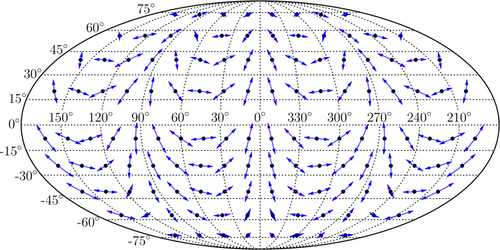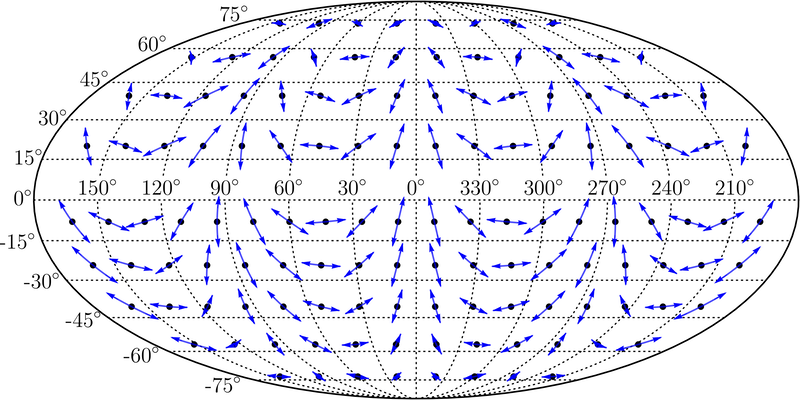Detecting Gravitational Waves by Watching Stars
This year’s Nobel Prize in Physics went to the developers of the Laser Interferometer Gravitational-Wave Observatory (LIGO) for detecting gravitational waves using large interferometers, but there are other techniques that could work. One method involves measuring the small displacements of stars that we would see as a gravitational wave passed through the Earth’s neighborhood. New calculations show that detection should be feasible using the high-resolution data on star positions (astrometry) provided by a space telescope called Gaia. This method would be sensitive to extremely low-frequency waves produced by mergers of supermassive black holes and possibly even by the big bang.
Gravitational waves (GWs) are generated by violent events, such as the collisions of black holes or neutron stars, objects whose extreme density strongly warps the surrounding spacetime. LIGO detects a GW by the stretching and squeezing it produces, but a passing GW would also cause the Earth to oscillate in its location with respect to the stars. So distant stars, viewed from Earth or from an orbiting space telescope, would seem to temporarily shift position in a predictable way.
Detection of GWs by observing extra-galactic objects, rather than stars, was suggested in the 1990s [1, 2]. And large networks of astronomers are already gearing up to detect GWs via their effects on radio emissions from pulsars, for which the highly regular stream of fast pulses would be slightly shifted in frequency [3] (see 12 May 2017 Q&A). Now astronomer Christopher Moore of the University of Cambridge in the UK and his co-workers have predicted the fingerprint that a GW would leave in the massive field of stars observed by the European Space Agency’s (ESA’s) Gaia space telescope. The observatory was launched in late 2013 to make high-precision observations of the positions of stars in our Galaxy.
The data from Gaia will be released in the early 2020s. Then, says Moore, “Gaia will make measuring this effect a realistic prospect for the first time.” While Gaia was being designed, researchers recognized that GW detection would be one potential use of the instrument [4]. Many factors contribute to the feasibility of the approach, including the precision and long duration of the astrometric measurements. Gaia will observe about a billion stars over 5–10 years, locating each one of them at least 80 times during that period. Observing so many stars is the major advance provided by Gaia, says Moore.
He and his colleagues show that GWs would produce a characteristic pattern of changes to the positions of all of the stars. The researchers simulated a GW produced by a pair of supermassive black holes orbiting one another and showed that it should be detectable from the measurements on 100,000 stars by Gaia. (Analyzing a billion stars would be too computationally demanding.) The method will be effective for GWs of extremely low frequency, a few microhertz to nanohertz, meaning that a single oscillation could take years.
Success is not guaranteed, however. “It could be that all the waves at these ultralow frequencies are too weak even for Gaia to detect,” says Moore. He says that the most likely source of GWs visible in the Gaia data will be a pair of supermassive black holes bound in a tight orbit with a period of roughly a year and located in the center of some large, relatively nearby galaxy. Such objects could have between 10 million and 100 million times the Sun’s mass.
“This is a nifty idea and is worth an effort,” says astrophysicist Carl Gwinn of the University of California at Santa Barbara, although he says that it will be challenging to eliminate conflicting signals from instrumental effects such as fluctuations in the spacecraft orientation.
Jos de Bruijne, deputy project scientist for the Gaia mission at ESA, confirms that the proposals and results of simulations are consistent with the capabilities of the instrument. According to Gwinn, a space-based instrument is required to see such effects, as refraction in the Earth’s atmosphere would prevent observation by ground-based telescopes.
De Bruijne says the approach might reveal GW sources not easily visible to interferometric detectors like LIGO, including primordial GWs produced in the inflationary epoch of the big bang. Gwinn adds that Gaia should also be able to see GWs emitted when stars from a host galaxy merge with the central supermassive black hole, which should be a fairly common occurrence.
This research is published in Physical Review Letters.
–Philip Ball
Philip Ball is a freelance science writer in London. His latest book is How Life Works (Picador, 2024).
References
- V. B. Braginsky, N. S. Kardashev, A. G. Polnarev, and I. D. Novikov, “Propagation of Electromagnetic Radiation in a Random Field of Gravitational Waves and Space Radio Interferometry,” Nuovo Cimento B 105, 1141 (1990); https://link.springer.com/article/10.1007/BF02827323.
- T. Pyne, “Gravitational Radiation and Very Long Baseline Interferometry,” Astrophys. J. 465, 566 (1996).
- J. A. Ellis, F. A. Jenet, and M. A. McLaughlin, “Practical Methods for Continuous Gravitational Wave Detection Using Pulsar Timing Data,” Astrophys. J. 753, 96 (2012).
- S. A. Klioner, “Gaia-like Astrometry and Gravitational Waves,” arXiv:1710.11474.





